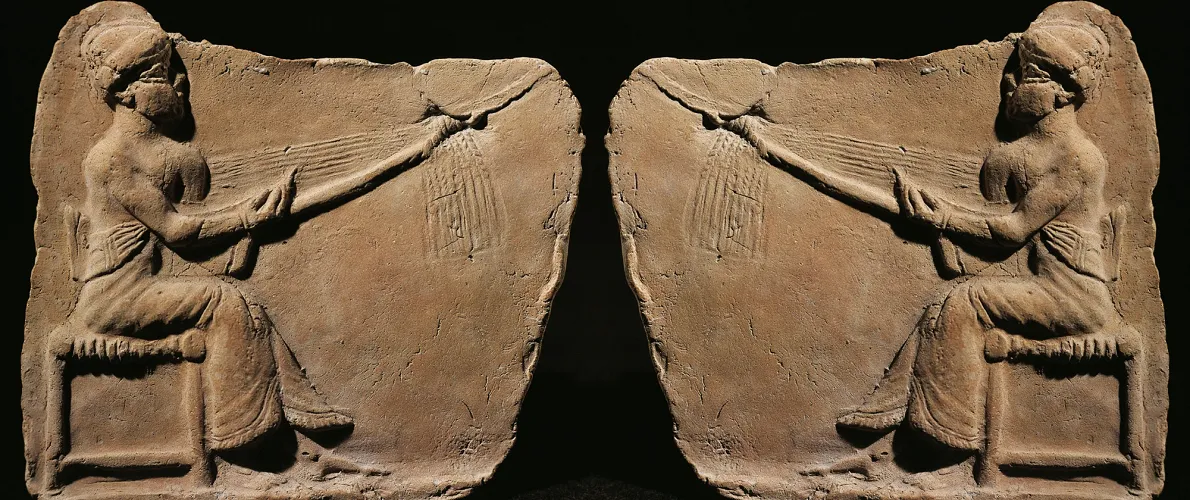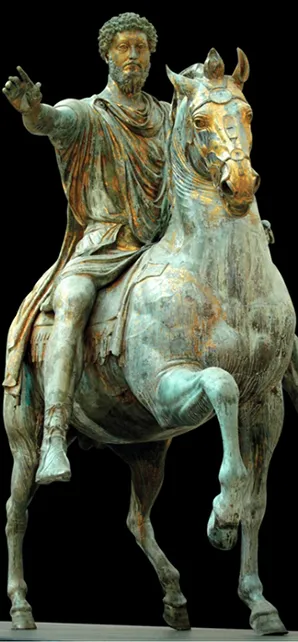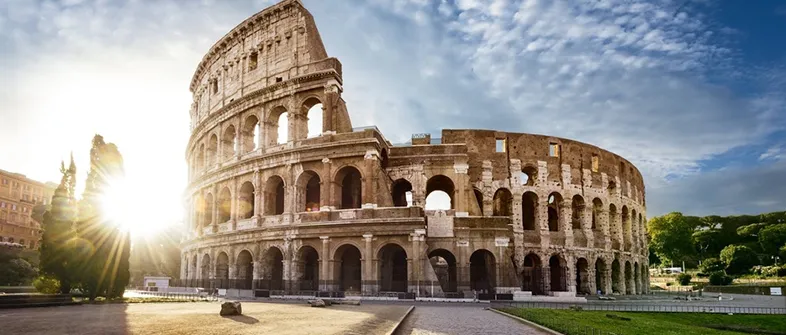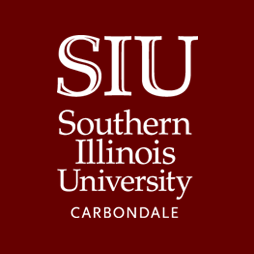- Ancient Artistic Practices
Ancient Artistic Practices
AD 350
The grandeur of ancient objects is stunning. But there is so much more to them than just their beauty. Have you ever wondered how these astonishing things were created in the first place? Just consider, for example…..
➤ Greek clay vessels: How on earth did ancient Greeks construct pottery kilns capable of reaching 950º Celsius (1740º Fahrenheit)?! What did they burn for fuel? How were clay vessels thrown, glazed, and fired?
➤ The quarrying and transport of marble and other stones in the ancient world: How were these massive blocks weighing many tons (!) extracted from the ground, hauled over land, rafted up and down rivers, loaded onto ships, shipped hundreds of miles across the Mediterranean, and transported to workshops and construction sites? How were these logistics of transport socially and culturally embedded? What role did slavery and the military play?
➤ Tools: Ancient sculptors used pickaxes and marble saws, chisels and drills, abrasives and waxes. How did they even manage to carve marble — let alone granite (!) — without steel tools or modern power? What were the fundamental differences between Greek, Roman, and Egyptian approaches to the carving process?
➤ And what about Greek bronze statues? What about Roman mosaics, glass vessels, and wall paintings? How were these made?
This course explores the materials, tools, techniques, and other physical components of Greco-Roman artistic practice, with an eye to the cultural values that Greeks and Romans attached to these physical components.
- Ancient Technologies and the Greek Philosophers
Ancient Technologies and the Greek Philosophers
For more information about this course, please contact the instructor,
Professor Robert Hahn.
PHIL
How can we explain the origins of Greek philosophy? If we look at how the early philosophers thought and wrote, we find evidence of technologies and technical analogies to describe the origins of the world, the formation of the heavens, the fundamental structure out of which the cosmos is built. This evidence includes:
- orienting pyramids and temples to cardinal directions,
- measuring the height of pyramids by their shadows,
- measuring the distance of a ship at sea,
- ancient surveying and engineering techniques that led to geometry,
- making a map of the Earth,
- a seasonal sundial,
- a model of the cosmos,
- the invention of coinage,
- and even the production of industrial textiles.
This course will uncover these ancient technologies and then apply them to the surviving evidence about the Greek philosophers to see what new insights we can discover about the how, when, where, what, and why of its beginnings. From this exploration, can students become more philosophical?
- Archaeo-Enginerring
Archaeo-Engineering.
For more information about this course, please contact the instructor,
Professor Frances Harackiewicz.
ENGR 305-3
Archaeologists have discovered marvelous inventions from the ancient world, long before engineering was considered to have been founded as a modern profession. How did ancient people measure time and location, travel, communicate, shelter, obtain food and water, or wage war? What propelled their inventiveness?
Some canonical discoveries have much to teach in terms of humanities and history as well as science and engineering. Using modern tools, feats of ancient engineering will be studied and modeled digitally or physically. Important engineering projects or inventions of the past covered such as sun dials, Stonehenge, the Antikythera mechanism, Roman roads, siege machines and aqueducts.
- Archaeology of Ancient Egypt
Introduction to the Archaeology of Ancient Egypt
For more information about this course, please contact the instructor,
Professor Gretchen Dabbs.
ANTH 340E/430E
What if I told you no one knew King Tut existed before his tomb was discovered and opened in 1922? Most people are aware of ancient Egypt in a very specific way, their knowledge guided by the fantastic and highly publicized discoveries of the last century of archaeological research:
- Pyramids!
- Mummies!
- Previously unknown tombs!
- Heart disease in the mummy of a lesser princess!
However, the texts written inside temples and tombs of Egypt during the time of the Pharaohs were highly restricted and written by and for specific audiences. Only the elites and royals would have been able to read them. Only royals and elites would have even had a large-scale rock cut tomb to provide texts. Only about 1% of ancient Egyptians were literate. What then of the other 99%, those that would have largely driven the Egyptian economy as the productive manufacturers and farmers?
This course focuses on understanding the broader scope of ancient Egypt beyond the monumental structures left behind by royals and elites to focus on the daily lives and lived experiences of the non-elite (those like you and me!) through analysis of archaeological remains of houses, non-elite burial grounds, and other records. The Pyramids, mummies, and statuary of ancient Egypt focus on what life was like among the highest elite. This course will use the archaeological site of Tell el-Amarna as the primary lens for discussions on the lives of the non-elites that would have comprised the bulk of the population. Amarna represents what remains of a single lens (15-20 year) occupation of an ancient capital city occupied by an estimated 50,000 individuals.
* The instructor for this course, Dr. Dabbs, has been working as a bioarchaeologist (study of ancient human skeletal remains) at Amarna, for more than a decade. Her research work has focused on the human skeletal remains from four non-elite cemeteries.
- Expressions in Architecture
Expression in Architecture
For more information about this course, contact the instructor,
Professor Jon Davey.
ARC 314i
Expression in Architecture covers both the practice and the discipline of architecture. The course introduces you to how architects design buildings as well as the history of architecture and how the built environment affects humans.
Topics include Egyptian architecture, from the Great Pyramid to the Burj Khalifa - one of the most famous buildings in the world at over 2,484 feet tall. Vernacular, popular, high style and sustainable architecture are also addressed.
The course teaches sketching buildings and the completion of your residence will be achieved using computer-aided design (an easy to use software). The course is taught by a professional architect, referencing examples of actual practice, and addresses the interconnectedness of nature, the arts, history, environmental psychology, and architecture using the built environment as the foundation for the study.
Students will learn to critically examine the built environment by learning how architecture expresses human cultures, social structures, economic and political status, and spiritual beliefs.
- Geomythology
Geomythology
For more information about this course, please contact the instructor,
Professor Ken Anderson.
GEOL 329I and Geol 329H (honors section)
For centuries we’ve been taught that the myths that have come down to us from the ancient world are entirely fiction. After all, they’re filled with gods and goddesses, spectacular creatures, monsters and heroes. What else could they be except flights of fantasy to moralize, or amuse and frighten the ignorant and the foolish?
Not so fast! It turns out that many of these accounts might actually have their roots in reality. Careful reading of many of these ancient stories in their original historical context suggests that they might actually be attempts to describe and explain events that at the time were indescribable, and inexplicable. Events that shook the foundations of the ancient world – sometimes literally.
Events like earthquakes, volcanoes and other things that today would be called “Geohazards”, where beyond explanation in the past. But when they occurred – and they did occur – their impact on the people they affected was enormous. So people needed to find way to explain and describe what they had experienced and to pass on those descriptions as both collective memory and as a warning to future generations.
Geomythology explores a simple idea: that many myths encode information about real events that occurred in the distant past. It examines the factors that affect the transmission of information over long periods of time, especially when that information is passed on as oral traditions, then reviews a series of case studies of specific myths and families of related myths and discus how those myths might be distorted descriptions of real events.
Topics covered include:
- The Nature of Mythology
- Origins and Creation
- Eden and Golden Ages
- Geology and Geohazards
- Greek Geomythology
- Flood Myths
- Mythical Creatures and Dragons
- The Oracle of Delphi
- Celestial Phenomena
- Jericho and the Cities of the Plain
- Atlantis and Thera
- The Exodus
- Roman Art & Architecture
Roman Art & Architecture
AD 310B / CLAS 310B
This course is devoted to ancient Roman art and architecture, in all its astonishing variety. We will turn our eye to a wide variety of objects — from statues and public buildings to wall paintings and mosaics, pottery and sarcophagi — and consider everything from the most imposing and bombastic forms of art to the most whimsical and quirky: from cult images in majestic temples to raunchy paintings in notorious brothels, from monumental theaters and amphitheaters to secluded private interiors and family tombs, from epic historical scenes glorifying human conquerors to fantastic mythological scenes celebrating gods and heroes, satyrs and nymphs, the divine and the dead.
Above all we will approach these physical remains of the Romans as a means of gaining insight into their cultural habits and their view of the world. But questions of technology and practice will also concern us. Among other things, we will address:
- The amazing technology that was Roman concrete: how Romans discovered concrete, and deployed it to construct a staggering variety of otherwise impossible buildings.
- Roman aqueducts and water transport.
- Ancient quarrying practices and Roman technologies & systems for moving massive blocks of stone vast distances.
- Massive bronze statues and the technologies for casting them.
- The pigments and techniques of Roman painting, and how it is that any have survived at all.
- Senior Projects
Ancient Practices Senior Projects
The capstone requirement for completion of the Ancient Practices minor is completion of at least 3 credits hours of a 400 level senior project. (Students are normally required to complete 9 credit hours of acceptable foundational courses before attempting their senior project requirement, but in some cases requirements may be met concurrently with approval of the Director of the Ancient Practices program.)
Student have three options for completing this requirement:
- Univ 431
- An approved equivalent program of studies within their own major on a topic relevant to Ancient Practices
- Approved immersive study abroad, (e.g. Philosophy 490-800/801 Ancient Legacies-Greece/Egypt)
Univ 431
Univ 431 is a capstone course of study created specifically for satisfaction of the senior project requirement for the
Ancient Practices minor. Students will usually have completed at least 9 credit hours of relevant course work prior to undertaking this class. Students enrolled in this course will be expected to complete a course of individual study, research or advanced studies related to some aspect of life in the ancient world. This study will be completed under the supervision of a member of the faculty. Individual projects must be approved by Ancient Practices academic steering committee prior to registration. Specific deliverables will be determined by the nature of the work undertaken and will be defined by the supervising faculty member, but will include a written report for review by Ancient Practices academic steering committee and a concise summary suitable for online publication.
Completion of Univ 431 will automatically satisfy the senior project requirement for the
Ancient Practices minor but may not also count for credit towards other degree requirements (i.e. may not count for credit as an elective towards any particular major).
Approved Equivalent Program
It is anticipated that most students will prefer to satisfy the senior project requirement by completion of an equivalent senior project/senior thesis/independent study or similar advanced course of studies that simultaneously satisfies requirements for their own major. In this way, credit hours completed can be counted toward both the student’s own degree requirements within their own major and also to satisfaction of the requirements of the Ancient Practices minor. Requirements of the project to be completed will be determined by the requirements of student’s own degree program, and the specific topic selected will be relevant to some aspect of life in the ancient world. Topics chosen must be:
- relevant to some aspect of life in the ancient world,
- completed under the supervision of a member of the faculty and,
- approved in advance by the Director of the Ancient Practices program (or their designee).
For example:
- Engineering students might choose to satisfy this requirement by completion of their senior design project (Eng 495) by constructing a machine modeled after a Roman era device
- Fine arts students might choose to produce an Objet d'art using ancient materials or methods
- Science students might choose to reproduce an ancient material (e.g. pitch?, glue? pigment? etc.) using traditional methods then analyze the resulting product.
- Media arts students might produce a 3D digital model of an ancient structure or object that accurately reflects the characteristics of the ancient original
- Fermentation science majors might brew beer or mead using traditional ancient recipes and ingredients
- And so forth.
Students are encouraged to develop proposals for relevant potential projects that are of particular interest to them. We strongly encourage students to begin thinking about potential projects early and to initiate conversations with potential faculty supervisors and with the Ancient Practices program early to discuss their ideas, so that final projects are appropriate with respect to their scope, practicality and subject matter.
In addition to the requirements of their home program, all student substituting an alternative course for satisfaction of the senior project requirement of the Ancient Practices minor will be required to submit at least a summary report of their project, suitable for online publication, to the Ancient Practices program.
Ancient Legacies Study Abroad Program
Students that are unable to complete a suitable senior project may satisfy the capstone requirement for the minor by completion of at least 3 credit hours of approved study abroad. E.g. by participation in Philosophy 490-800/801 Ancient Legacies-Greece/Egypt. See the Ancient Legacies travel abroad site, or contact the Ancient Practices program or Professor Robert Hahn for additional information. Note: Students are responsible for all costs associated with participation in this study abroad program.
- Wining & Dining in the Ancient World
Wining and Dining in the Ancient World
For more information about this course, please contact the instructors,
Ms. Lynn Gill and
Professor Matt McCarroll.
HND 300 also cross-listed as FERM 300
Ask any college student what they like to do in their spare time and most will mention either eating, drinking, or socializing. These activities, while enjoyable, actually have historical significance. Since the beginning of time, food and drink have been basic needs for every human being. However, the meaning behind these practices varied from culture to culture. For example, the ancient Greeks began their morning with barely bread dipped in wine. While this may be frowned upon in today’s culture, this combination was thought to have healing powers. Also, the focus of a meal was to spend time socializing and please the palate, not to fill the stomach. In today’s climate, the goal of eating changed to accommodate large portion sizes and busy schedules with less emphasis on the ancient philosophy of eating for wisdom, spirit, and nourishing the soul.
This course will take you back in time to explore ancient dietary customs and symbolism, including how materials for food and drink were gathered, processed and prepared, and their influence on health. We will explore fermentation as a processing and preservation method and examine evidence of the impact of fermentation on the agricultural revolution and the dawn of civilization.
Specifically, this course will focus on:
- Foods associated with different cultures in ancient times
- Symbolism behind common ancient foods
- Health status of ancient population compared to the health status of modern times
- How food and drink were gathered, processed and prepared
- Creating recipes from ancient food products
- Fermentation as a processing and preservation method and examine evidence of the impact of fermentation on the development of germ theory, human health, the agricultural revolution and arguably even the dawn of civilization.


![]() View a full list of the requirements for the Ancient Practices Minor.
View a full list of the requirements for the Ancient Practices Minor.




